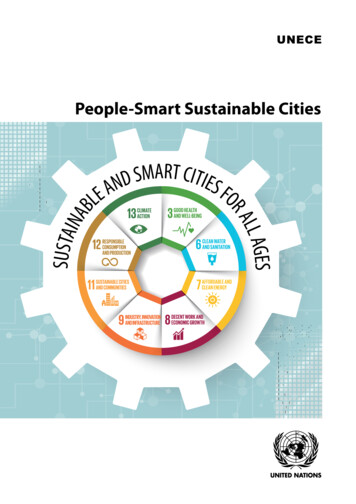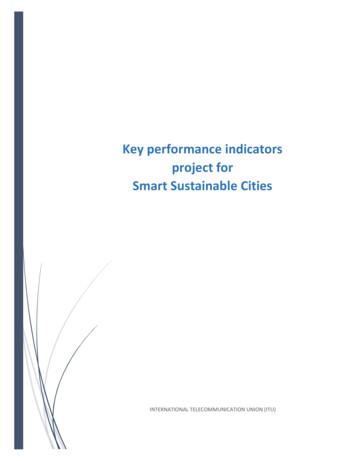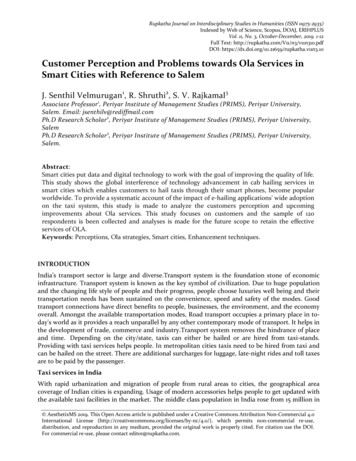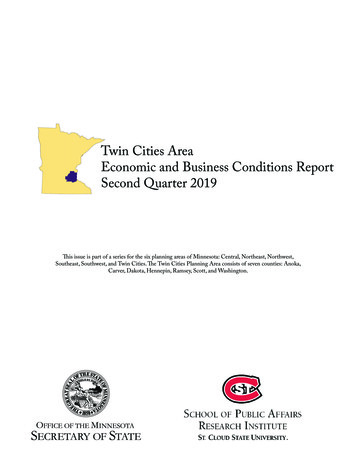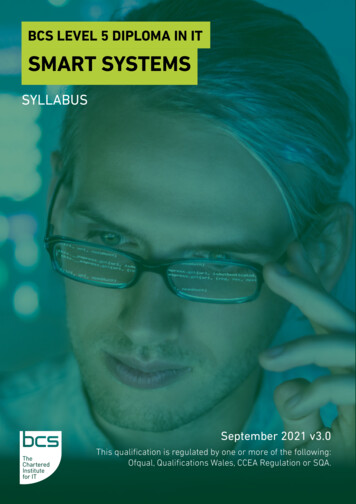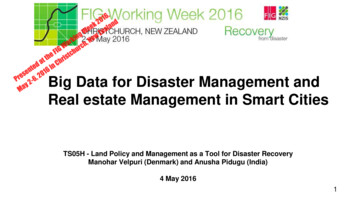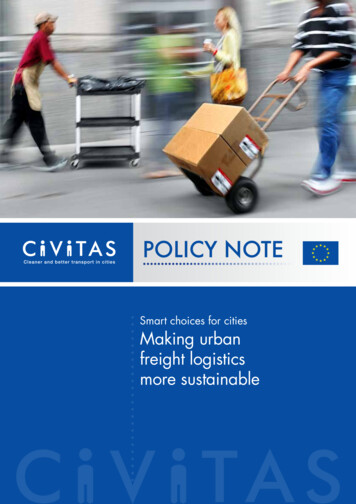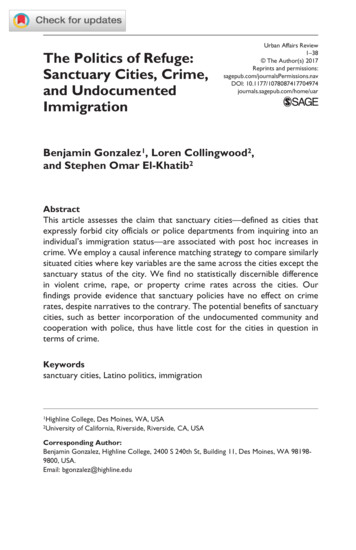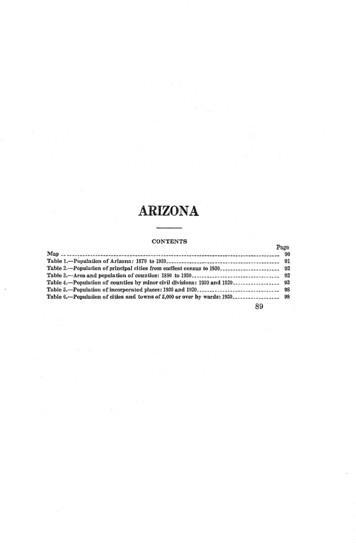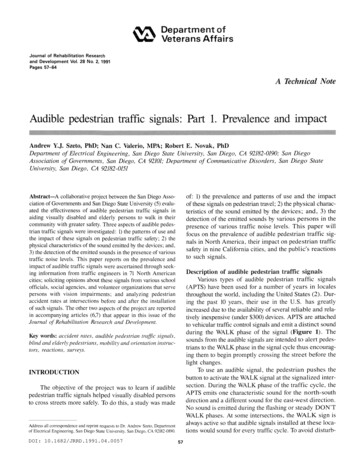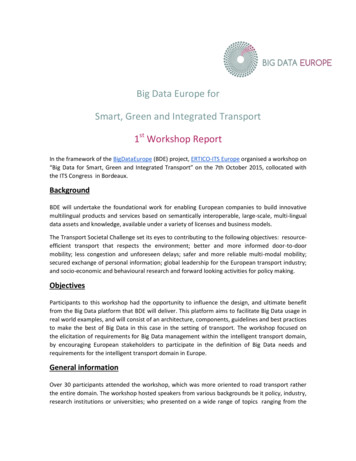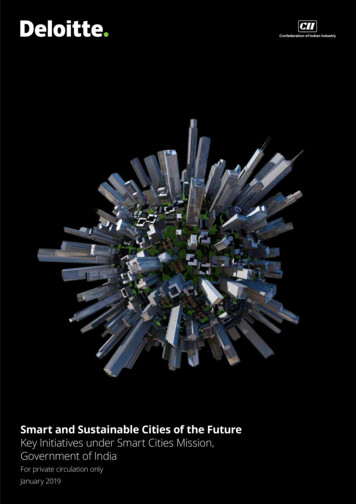
Transcription
Smart and Sustainable Cities of the FutureKey Initiatives under Smart Cities Mission,Government of IndiaFor private circulation onlyJanuary 2019
Smart and Sustainable Cities of the Futureii
Smart and Sustainable Cities of the FutureContentsOverview of smart cities 02Introduction 02Overall strategy 04Governance and institutional mechanism 05Financing of smart cities 06Financial landscape and key sectors of smart cities 07Focus and investments by sector 07Status of smart cities mission 08Representative sector-specific projects and learnings 09Overall progress of smart city projects 09Ease of living 09Digital technology 10Sustainability 11Concluding remarks 1201
Smart and Sustainable Cities of the FutureOverview of smart citiesIntroduction A lthough there are multiple definitions of “smart city”, the termmeans aspirational levels of infrastructure and services in theentire urban ecosystem for citizens. smart city is an economically vibrant city that provides itsAcitizens a good quality of life using Information Communicationand Technology (ICT) solutions. The Smart Cities Council1defines a smart city as one that uses digital technology forall city functions. Similarly, World Bank 2 defines a smart cityas a technology-intensive city that has sensors installedeverywhere and offers highly efficient public servicesusing information gathered in real time by thousands ofinterconnected devices. Further, a smart city cultivates a betterrelationship between citizens and governments using theavailable technology. It relies on feedback from citizens to helpimprove service delivery. It puts in place mechanisms to gatherthis information. T he following figure shows the key components of a smart city:Key Components of a Smart CityWhat all contribute towards making a city smart?SMART LIVING Sewerage & Sanitation Core Infrastructure High Quality of Life Water Supply Smart Solutions overlying Basicamenities Electricity Housing Clean & sustainable environment Citizen Safety Public Open spaceSMART GOVERNANCE IT connectivity Online citizen servicesSMART PEOPLE EducationSmartLivingSmartGovernanceSMART ECONOMY Employment tSMART MOBILITY Transport Green Building Traffic Renewable Energy WalkabilitySource: Deloitte nt/brief/smart-cities02 Entertainment & CulturalActivitiesSmartMobilitySmartEconomySMART ENVIRONMENT Pollution Health
Smart and Sustainable Cities of the FutureThe desired urban ecosystem for a smart city can be representedby the four pillars of comprehensive development—institutional,physical, social and economic infrastructure3. To cater to thisholistic development, the Ministry of Housing and Urban Affairs(MoHUA) launched the Smart Cities Mission on 25 June 2015 4.The selection process5 for the participating cities includes a“challenge method” that comprised two stages. In stage 1, thenumber of eligible cities that respective states can nominatewere informed and the states selected potential smart citiesthrough an intra-state competition. About 110 cities participatedin the selection process, and prepared and submitted smart cityproposals for evaluation.Cities prepared smart city proposals after extensive interactionswith citizens. These interactions focused on identifying thekey challenges citizens faced and areas in which they wantedimprovements. This made the process interactive and inclusive.In stage 2, the selection of smart cities across India is completed.It took four different rounds to select 100 smart cities. Thefollowing graph shows a brief timeline of the mission progress, asof June 2018:Overview of Smart Cities Mission ProgressSmart CitiesMissionlaunchedRound 2 – 40cities selectedJune, 2015Round 4 – 9cities selectedSeptember, 2016January, 2016Round 1 – 20cities selectedJanuary, 2018June, 2017Round 3 – 30cities selectedJune, 2018Shillong getsselected as the100th SmartCitySource: 6 Smart Cities Mission, An overview of ntation/5c4834d78cdb30 SCM%20Prez for%20CLAF v3.pdf03
Smart and Sustainable Cities of the FutureOverall strategy7The Smart Cities Mission has an integrated pan-city and area-based development strategy.Pan-city development follows a whole of the city concept and envisages the application of selected smart solutions to the existing cityinfrastructure. The application of these solutions involves the use of technology, information, and data to improve infrastructure andservices. These solutions would cover all citizens.Area-based development includes redevelopment, retrofitting, and greenfield projects in a contiguous pilot area within the city, asshown below:Key Components of Area-based Development StrategyRedevelopment ProjectRetrofitting ProjectGreenfield Project Replacement of the existing builtup environment and enable cocreation of a new layout Planning in an existing built-up areato achieve smart city objectives,along with other objectives Minimum area of 50 acres required Minimum area of 500 acresrequired will be identified by thecity in consultation with citizens Introduction of Smart Solutionsin previously vacant area usinginnovative planning, plan financingand plan implementation tools Potential areas: Old slum areas,Core City areas Existing structures largely to load/presentation/5c4834d78cdb30 SCM%20Prez for%20CLAF e/strategy.php04 Minimum area of 250 acresrequired Could be located either within thelimits of the Urban Local Body orUrban Development Authority(UDA)
Smart and Sustainable Cities of the FutureThe smart city proposal of eachshortlisted city includes either oneor a combination of the area-baseddevelopment and pan-city initiativesfeaturing smart solution(s). A key feature inthe smart city plan is to try to ensure thatthere is a sense of inclusiveness amongcitizens, irrespective of age, gender, andeconomic status. The Smart Cities Missionmandated that the proposal has at leastone citywide smart solution benefiting allcitizens.metropolitan cities, to plan and implementsmart city initiatives. With a large outlayon infrastructure and ICT solutions, manycities did not have experience or expertisein managing procurement or monitoringprojects of such a scale. There was a needfor involving professional expertise at thecity level.Governance and institutionalmechanismSpecial purpose vehicle (SPV) forimplementing the smart city planAs multiple government departments andagencies provide various city services, itis a challenge to coordinate the activitiesof these departments or agencies (whichtend to work in silos). Given the smartcity programme following a whole of thecity concept for urban transformationand the experience of previous urbandevelopment initiatives, there is needfor an institutional mechanism to ensurecoordination among all players involvedin city infrastructure and services. Theseplayers need to coordinate to design, plan,and implement smart city initiatives. An SPV implements the mission atthe city level. It is required to plan,appraise, approve, release funds,implement, manage, operate, monitor,and evaluate smart city developmentprojects.Another key concern was the capacityof human resources, particularly in non-10.11.12.The Smart Cities mission proposed thefollowing institutional and governancemechanisms: The SPV has to be a limited companyincorporated under the CompaniesAct, 2013, at the city-level. A full-timechief executive officer (CEO) headsthe SPV. The SPV needs to havenominees of central government, stategovernment, and urban local body(ULB) on its board. As of May 2018,91 SPVs had been formed under theSmart Cities Mission10.Structure of SPVAccording to the guidelines ofMoHUA11, an SPV has to be structuredin such a way that the state or UnionTerritory (UT) and ULB are the promoterswith 50:50 equity shareholding. Theprivate sector or financial institutionscould be considered for taking anequity stake in the SPV, provided theshareholding pattern of 50:50 of thestate or UT and ULB is maintained andthe state or UT and ULB together have amajority shareholding and control ofthe SPV.According to the guidelines, a full-timeCEO heads the SPV and reports to theboard of directors. The CEO is appointedfor a fixed-term of three years. Theboard of directors is required to haverepresentatives of central government,state government, ULB, and independentdirectors, in addition to CEO andfunctional directors. Chief operationsofficer, chief financial officer, companysecretary, and other technical resources(appointed in line with the humanresource policy approved by the SPVboard) will support the CEO.Press Release by Ministry of Housing and Urban Poverty Alleviation on 17 th May, 2018: http://pib.nic.in/newsite/PrintRelease.aspx?relid loadfiles/files/SPVs.pdf05
Smart and Sustainable Cities of the FutureFunctions and Responsibilities of SPVThe following are some key functions andresponsibilities of SPV12:i. Conduct technical appraisal andsanction projectsii. Execute projectsiii. Take measures to comply with therequirements of MoHUA with respectto the Smart Cities Missioniv. Mobilise resources within timelines forproject executionv. Approve and take action on review, andmonitor reports of third-party agencyx. Determine .0and collect user charges,collect taxes, surcharges, etc., asauthorised by the ULBFinancing of smart citiesAccording to the Smart Cities Mission, thecentral and state government funds wouldmainly finance smart cities. Resourcesare also likely to come through publicprivate partnerships and convergencewith other government schemes, such asAtal Mission for Rejuvenation and UrbanTransformation, Swachh Bharat Mission,and Digital India.vi. Oversee capacity building activitiesvii. Monitor project completion activitiesviii. Review activities related to the Mission,including budgeting, implementingprojects, preparing Smart city plan(SCP), and coordinating for the Missionor schemesix. I ncorporate joint ventures and enterinto public-private partnerships forthe implementation of the smart citiesprogramme11.12.06Funds are also expected to be raisedthrough borrowings from bilateral andmultilateral sources, such as WorldBank and Asian Development Bank.Municipal bonds will also be used to raisefunds. The city’s own revenue, largelyobtained through property, profession,entertainment, advertisement taxes, andother taxes, would also be used. The SPVcan also raise funds from other uploadfiles/files/SPVs.pdfsuch as user charges for parking, water,and sewerage services.Significant investment in terms ofcapital cost is expected in cities to setup infrastructure and facilities for smartinterventions, the challenge of fundingoperations and maintenance, and assetreplacement is a key concern for citiesbeyond the mission period.The Smart Cities mission provides statesor cities an opportunity to examineinnovative funding mechanisms. Theseinclude mechanisms that many citieshave adopted across the world: (i) valuecapture finance in terms of monetisingdeveloped land, (ii) rentals from sharingurban assets such as utility ducts and cityoptical fibre networks, (iii) bettermentlevy, tax incremental financing from cityareas benefiting from smart interventions,(iv) transferable or additional floor spaceindex, and many more.
Smart and Sustainable Cities of the FutureFinancial landscape and keysectors of smart citiesAs part of the Smart Cities Mission, an investment of INR2.04 lakh crore is planned for various projects13 .Planned sources of funds include central and stategovernments (45%), convergence of various governmentschemes (21%), public-private partnerships (21%), debtsor loans (5%), cities’ own funds (1%) and funds from othersources (8%), as depicted in the chart below.Planned Source of Funds for Smart CitiesOwn, 1%Debt / Loans, 5%Others, 8%Until March 2018, the government of India had releasedfunds worth INR 10,459.2 crore under the Smart CitiesMission14 . These funds have been released over a period ofthree years: FY 2015-16 (INR 1,467.2 crore), FY 2016-17 (INR4,492 crore), and FY 2017-18 (INR 4,499.5 crore).Focus and investments by sectorAs observed from the chart below, the urban transport, areadevelopment, economic, and energy sectors have emergedas focus sectors in smart cities. These sectors account formore than 50% of the total planned investments. Initiativesacross the water supply and sewerage sectors, IT or ICTsolutions (including automation or e-governance facilities),and the housing sector account for 10.2%, 9.5% and 6.4% ofthe total planned investments, respectively.Investments in 99 cities by SectorPPP,21%Convergence,21%Center State Govt.,45%Safety1.80%Solid Waste Management2.40%Social Sectors2.50%Storm Water Drainage2.50%Environment2.60%OthersNMT & PedestrainSewerageWater SupplySource: Ministry of Housing and Urban Affairs, 2018, Presentation on SmartCities Mission to Consultative Committee (Urban Development)HousingIT/ICT mic DevelopmentArea DevelopmentUrban Transport10.10%12.70%15.00%16.60%Source: Ministry of Housing and Urban Affairs, 2018, Presentation on SmartCities Mission to Consultative Committee (Urban Development)13.14.Ministry of Housing and Urban Affairs, 2018, Presentation on Smart Cities Mission to Consultative Committee (Urban rpage/fund-release.php07
Smart and Sustainable Cities of the FutureStatus of smart cities missionTo date, the Smart Cities Mission picked up momentum and shown significant progress in the past two years. According toMoHUA, the government of India, as on 31 December 2018, projects worth over INR 1 lakh crore has been tendered out bycities with work started or completed being nearly 60% in value terms, as presented in the charts below.Cumulative value of work tendered out by quarterCumulative value of work started/ completed by quarterIn INR Crores 1,20,000 1,05,000 90,000 75,000 60,000 45,000 30,000 15,000 0 1,02,027 76,721 34,283Dec-17 45,417Mar-18 54,289Jun-18Sep-18Source: Ministry of Housing and Urban Affairs, Government of India08Dec-18In INR Crores 70,000 60,000 50,000 40,000 30,000 20,000 10,000 033%27%growthgrowth24% 46,32146%growthgrowth 34,903 28,203 19,333 59,336Dec-17Dec-18Mar-18Jun-18Sep-18Source: Ministry of Housing and Urban Affairs, Government of India
Smart and Sustainable Cities of the FutureRepresentative sector-specificprojects and learningsOverall progress of smart city projects 15The following sections describe key initiatives under the Smart Cities Mission under three broad themes: ease of living,digital technology, and sustainability.Ease of livingEase of living projects involve the introduction of technology-enabled roads and transportation systems for the improvedmobility for citizens. The table below summarises the implementation progress of ease of living projects*:Status of Ease of Living ProjectsDetailsWork Started/CompletedSmart RoadsNumber of CitiesInvestments (in INR Crore)Under TenderingNumber of CitiesInvestments (in INR Crore)Smart Mobility35263,5291,7789211,9071,935Source: Ministry of Housing and Urban Affairs, 2018, Presentation on Smart Cities Mission to Consultative Committee (Urban Development). *As onJune 2018Smart road projects worth INR 3,529 crore have beencompleted or are in progress in 35 cities. Smart mobilityprojects related to non-motorised transport and public bikesharing projects worth INR 865 crore have been completedor are in progress in 18 smart cities.Smart mobility projects also include projects related to thecreation of transport infrastructure viz. provision of buses,development of bus stops, construction of foot-over andrail-over bridges or subways, and development of multimodal transit hubs. Projects worth INR 913 crore have beencompleted or are in progress in 12 cities, while projectsworth INR 1,615 crore are in the tendering phase in 14 cities.A case study on public bicycle sharing initiative is presentedbelow.Public Bicycle Sharing Project in BhopalTo promote non-motorised transport in the city, Bhopal Smart City Development Corporation Ltd. (BSCDL) launched thecountry’s first completely automated 24x7 bicycle sharing project under the Smart Cities Mission. With 50 fully automateddocking stations linked to the central control system, citizens can access bicycles via their smart phone or smart card.Users can also locate their bicycles through installed GPS devices and open the electronic lock by swiping the “My BusBRT” smart card. The project costed about INR 7 crore and was implemented on a public-private partnership mode.The initiative helped improve traffic flow, and contributed to the environment significantly. It has offset more than 7400kilogram of CO2 emissions since its launch after logging more than 34,000 clean kilometres.Source: https://smartnet.niua.org/weekly-update?m wu315.Ministry of Housing and Urban Affairs, 2018, Presentation on Smart Cities Mission to Consultative Committee (Urban Development)09
Smart and Sustainable Cities of the FutureKey LearningsThe success of a public bicycle-sharing project significantly depends on an efficient marketing and communication strategyand the right selection of a site.Efficient marketing and communication strategy: To ensure the success of this project in Bhopal, BSCDL adopted a marketingand communication strategy wherein advertisements, public relations and events, and identity media and website were thechosen channels of communication. These channels ensured the maximum number of targeted consumers are covered.Right selection of site: Choosing the right site location is important as the selection of a wrong site may lead to safety issuesfor users, lesser patronage, poor revenue generation, etc. To ensure the right selection of the site, BSCDL focused on keyparameters, such as area suitability and terrain, land use, existing public transport corridors, existing spots of high publictransport usage, areas of public interest, such as parks, and student population spots.Digital technologyDigital technology projects relate to improving governanceand easing the lives of citizens using information technology.Under this theme, smart cities have developed command andcontrol centres to control the overall functioning and monitoractivities in the city. These cities have also developed mobileapplications to ease the lives of the citizens so that they canaccess essential services through their mobiles. The followingtable gives us an overview of the implementation status of theprojects related to digital technology*:Status of Ease of Living ProjectsDetailsWork Started/CompletedCommand & Control CentresNumber of CitiesInvestments (in INR Crore)Under TenderingNumber of CitiesInvestments (in INR Crore)Mobile Applications23113,084393312,7192Source: Ministry of Housing and Urban Affairs, 2018, Presentation on Smart Cities Mission to Consultative Committee (Urban Development). *As on June 2018Command and control centres related projects worth INR 3,084 crore have been completed or are in progress across 23smart cities. Mobile application-based projects worth INR 39 crore have been completed or are in progress in 11 smart cities.Digital technology intervention largely refers to ICT-enabled pan-city solutions, including setting up internal command andControl Centres through which incidents across the city is tracked, reported and responded to leveraging multiple field levelsensors across the city. These addressed interventions like safety & security, intelligent traffic management, etc. Howeverthese solutions also has enabled accessibility and inclusiveness in keys areas of healthcare and education. A case study ofuse of ICT in government schools has been presented below.Transforming Government Schools in New DelhiTo make the teaching and learning process effective by addressing the learning needs of students using varying learningstyles, New Delhi Municipal Council (NDMC) is introducing ICT interventions in NDMC and Navyug schools. NDMC has set up444 smart classrooms with audio and visual smart boards, digital libraries with library automation systems, and tablet-basedsmart classes for assessment. Due to these initiatives, there is marked improvement in academic scenario in these schoolswith better class X and XII results, increased enrolment, and improved performance of both teachers and students.Source: https://smartnet.niua.org/weekly-update?m wu32Key LearningsTo make these ICT interventions successful, it is important to train teachers on the effective handling and integration of ICTwithin classrooms. Since the launch of the project, there has been significant emphasis on regular training of teachers ontheir subject and different digital platforms introduced in NDMC schools. Smart classes, digital lab, and tablet-based classeshave been successful because teachers received regular and comprehensive training. Teachers also received special in-houseweekly training to become accustomed to teaching through smart boards.10
Smart and Sustainable Cities of the FutureSustainabilitySustainability focused projects relate to creating sustainable solutions for essential needs of citizens. Under the Smart CitiesMission, projects such as smart water, smart wastewater, smart solar, and waterfront development have been undertaken.The following table summarises the implementation progress of sustainability projects*:Status of Sustainability Focused ProjectsDetailsWork Started/CompletedUnder TenderingSmart WaterNumber of CitiesInvestments(in INR Crore)Number of CitiesInvestments(in INR Crore)SmartWastewaterSmart 10177129804,707176660Source: Ministry of Housing and Urban Affairs, 2018, Presentation on Smart Cities Mission to Consultative Committee (Urban Development). *As onJune 2018Smart water projects worth INR 4,079 crore have beencompleted or are in progress across 40 cities and smartwastewater projects worth INR 2,623 crore have beencompleted or are in progress across 29 smart cities.In the area of renewable energy, solar electrification (smartsolar) projects worth INR 886 crore have been completed orare in progress across 49 cities.Place making projects such as riverfront developmentprojects worth INR 452 crore have been completed or are inprogress across 15 cities.A case study on water supply management using SCADA hasbeen presented below:Water Supply SCADA in AhmedabadWater treatment and water distribution services are key factors for the development of any city and all urban localbodies. In the first phase, Ahmedabad Municipal Corporation (AMC) has commissioned a network of the SupervisoryControl and Data Acquisition (SCADA) system across its distribution network to generate real-time data, and developstandard operating procedure for auto analysis and alerts for flow and energy. The SCADA system allows for local andremote control function and is equipped with safety shutdown features. It is integrated by AMC with the IntegratedCommand and Control Centre, to help in effective decision-making and save cost.Source: https://smartnet.niua.org/weekly-update?m wu33Key LearningsWhile most cities have adopted the SCADA system for water supply, the key feature that makes the project abreakthrough is that it is well integrated with the Integrated Command and Control Centre (ICCC)in Ahmedabad. Theintegration of SCADA with ICCC makes it possible to combine data from various sources, such as SCADA, complaintredressal system, surveillance cameras, and Geographical Information System . It helps perform pattern analysis, whichin turn leads to effective decision-making. This integration also helps improve the accountability of various agenciesinvolved in water supply.11
Smart and Sustainable Cities of the FutureConcluding remarksThe 100 Smart Cities Mission programmewas launched in 2015 and is expectedto be completed by 202316. As observedabove, some key projects, includingsmart roads or place making projects,aimed at improving the ease of living forcitizens have already been completedin some cities. This gives citizens thevisibility of the programme. As digitaltechnology is one of the major focusareas of the mission, command andcontrol centres have been completed incities such as Vishakhapatnam, Kakinada,and Bhopal. These centres are expectedto address issues of incidence reportingusing field-level sensors, planning ormonitoring response, and introducingdata evidenced urban planning.Sustainability focused projects such assmart water and waste management,solar electrification, and riverfrontdevelopment, are also being pursuedwith a focus on the conservation ofnatural resources and the protection ofenvironment.The Smart Cities Mission is a significanttransformation programme thathas highlighted the significance ofcomprehensive integrated developmentof cities. It has helped in bringing variousagencies involved in urban planningand management together through anSPV and ensuring a better standard ofliving for urban population (through16.12better coordination and management).The mission has not only allowed forcoordination among agencies butalso showed merit of comprehensiveprovision of urban services. Theintegration of urban services allows forbetter decision-making and thus betterservices. The mission has also helped inhighlighting the capacity and institutionalchallenges to all the urban stakeholders.It has provided a platform for the citiesto attempt to resolve these challengesthrough smart cost-effective solutions.Overall, the Smart Cities Mission is oneof the flagship missions of MoHUA,which has received global attention givenits scale and opportunity to bring intransformational changes in the urbanlandscape. This can serve as a case studyfor other nations. The mission has thepotential of taking India closer to the aimof being one of the smart nations in theworld.In the future, the key challengeis expected to be (i) ensuring thesustainability of interventions at the citylevel and (ii) extending benefits to othercities in the country not covered underthe current programme.cities. MoHUA has already undertakeninitiatives to explore additionalsources of revenues for cities. Thesesources include the monetisation ofdata and analytics generated throughthe integrated command and controlcentres in a city. The experience of citiesthat have successfully adopted suchbusiness models (including Copenhagen,Manchester, and Bristol) may be studied.These practices may be suitably adoptedfor other Indian cities by enactingpolicies at the centre or state level andbuilding capacity among city officials.The replicability of smart solutions toother cities may be considered throughthe proposed India Urban Data Exchangeinitiative planned by MoHUA. The urbandata exchange platform may enablecities to share their applications withother cities. This will reduce investmentrequirements for developing similarapplications for the recipient city andprovide a source for revenue generationto the city providing the application.Some states such as Madhya Pradeshand Tamil Nadu are setting up cloudbased platforms, which may allow othernon-participating cities in those statesto benefit from the applications andsolutions implemented, in the future.Funding will be the key requirementfor ensuring sustainability as well asreplicating the success stories in otherSource: Ministry of Housing and Urban Affairs, 2018, Presentation on Smart Cities Mission to Consultative Committee (Urban Development)
Smart and Sustainable Cities of the Future13
Deloitte refers to one or more of Deloitte Touche Tohmatsu Limited, a UK private companylimited by guarantee (“DTTL”), its network of member firms, and their related entities. DTTL andeach of its member firms are legally separate and independent entities. DTTL (also referred to as“Deloitte Global”) does not provide services to clients. Please see www.deloitte.com/about for amore detailed description of DTTL and its member firms.This material is prepared by Deloitte Touche Tohmatsu India LLP (DTTILLP). This material(including any information contained in it) is intended to provide general information on aparticular subject(s) and is not an exhaustive treatment of such subject(s) or a substitute toobtaining professional services or advice. This material may contain information sourced frompublicly available information or other third party sources. DTTILLP does not independentlyverify any such sources and is not responsible for any loss whatsoever caused due to relianceplaced on information sourced from such sources. None of DTTILLP, Deloitte Touche TohmatsuLimited, its member firms, or their related entities (collectively, the “Deloitte Network”) is, bymeans of this material, rendering any kind of investment, legal or other professional adviceor services. You should seek specific advice of the relevant professional(s) for these kind ofservices. This material or information is not intended to be relied upon as the sole basis for anydecision which may affect you or your business. Before making any decision or taking any actionthat might affect your personal finances or business, you should consult a qualified professionaladviser.No entity
05 Smart and Sustainable Cities of the Future The smart city proposal of each shortlisted city includes either one or a combination of the area-based
